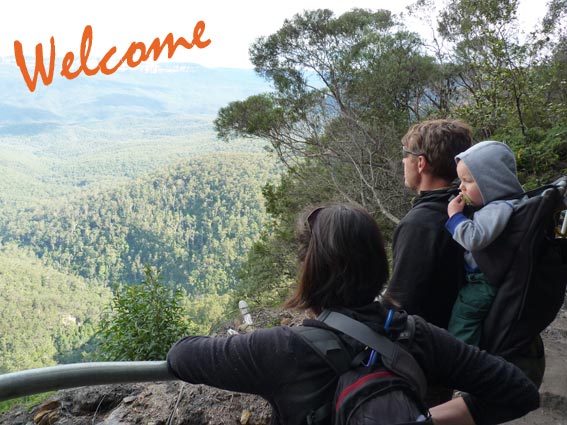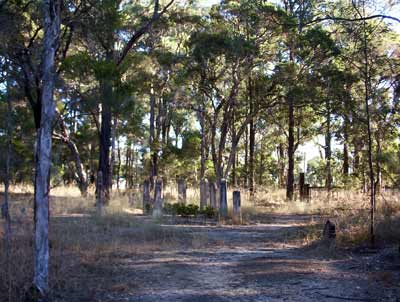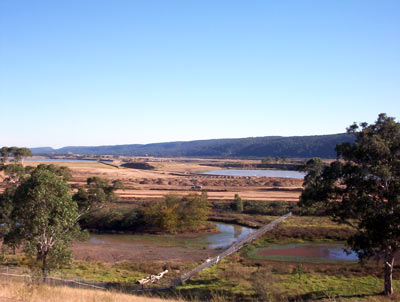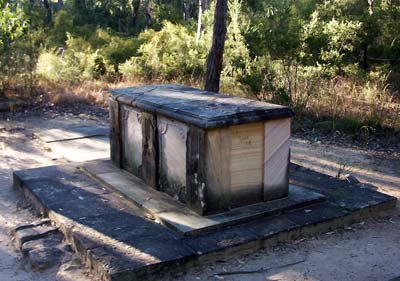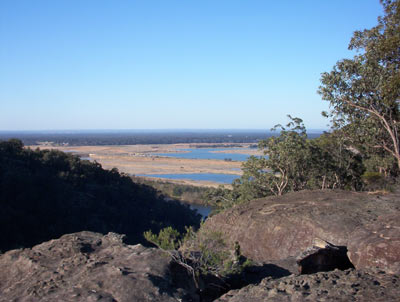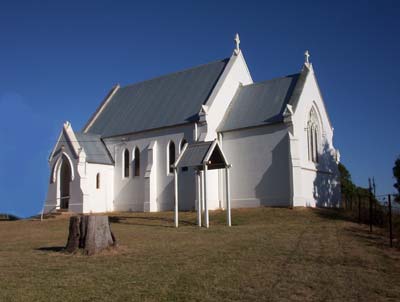 On Easter Monday this year I went looking for the Church of England Cemetery at Castlereagh, New South Wales. From Penrith, Castlereagh Road spears across the once fertile Nepean River flats that were divided into family farms by the first government land grants. These grants were given to former convicts and free settlers in the hope that their agricultural pursuits would provide food for the struggling, infant colony of New South Wales. Many of these early farmers are buried in the cemetery I was going to find.
On Easter Monday this year I went looking for the Church of England Cemetery at Castlereagh, New South Wales. From Penrith, Castlereagh Road spears across the once fertile Nepean River flats that were divided into family farms by the first government land grants. These grants were given to former convicts and free settlers in the hope that their agricultural pursuits would provide food for the struggling, infant colony of New South Wales. Many of these early farmers are buried in the cemetery I was going to find.
These days when you drive across the flats, you look down onto large areas of land where masses of earth have been removed to shape future parts of the Penrith Lakes Scheme. This area is quarried for sand, gravel and river pebble. The Lakes Scheme is seen as land remediation. It has totally changed the natural and built landscape of this historic region.
As you come into the present day district of Castlereagh, the white, glossy painted Christ Church glows on the rise above the river flats like a beacon. This church was built in 1878 after fire destroyed the school and church which were built originally for Henry Fulton, Castlereagh’s first parson.
Before all the changes to this area, it was possible to drive straight up Church Lane from Castlereagh Road to the church and then on to the cemetery. Now you have to test your navigational skills and drive further, before finding yourself back up on the rise in Church Street. The cemetery is in this street. Because it is unmarked and over run by trees and scrub, you have to look carefully to find it. It is surrounded on two sides by Crown Land. The cemetery is the only reminder left of “the Castlereagh” Governor Macquarie had in mind, when he announced his “Five Towns” in December 1810.
As part of a tour of inspection of the region, Governor Macquarie visited there in November 1810. He viewed the farms very favourably, but noted their perilous position when the river flooded. He attributed the “very mean and paltry” state of the residences to this constant threat. Leaving his carriage for horseback, he proceeded to “view the back line of Farms, and explore the Ground intended to be laid out shortly for a Township and place of security and retreat for the Settlers inhabiting this part of the Country”. He reckoned it to be not more than three miles from the river. Before returning to Sydney, he announced the names of his five new townships. This Nepean district was officially named Castlereagh, in honor of Lord Viscount Castlereagh. Macquarie recommended to those influential citizens of the district to begin encouraging the farmers “to lose no time in removing their Habitations, Flocks & Herds to these Places of safety and security”. These recommendations highlighted the Governor’s policy that land, especially fertile river flats, was to be exclusively used for cultivation and not for pasture.
Considering the scarcity of land in the colony, using it for pasture was deemed wasteful and was not to be encouraged. However, despite these plans, the residents of the Nepean district preferred to stay where they were.
Soon after Macquarie’s visit the site of the township was surveyed and blocks allocated. In January 1813, the year the Blue Mountains were finally crossed, William Cox began work on a two storey brick parsonage and outbuildings which took about a year and a half to build. This was almost three times as long as it took him to build the road over the Blue Mountains to Bathurst. He commenced building the mountain road in November the following year.
After the parsonage was completed, the plan was then to build a school house, mostly funded by the settlers. This building would also serve as a temporary church until one could be built. Macquarie saw the establishment of schools and churches as vital to the wellbeing of these new communities. He believed that they “greatly contribute to the Reformation of the Morals of the lower orders of people, and to the implementing religious Principles in the Minds of the rising Generation.” For many of the early settlers, the building of churches and the establishment of cemeteries also subtly offered some continuity and meaning to their very existence. Church dogma and ritual would have given some people a sense of the familiar in this strange country. For others, the sanctity and refuge provided by a church would have been a great comfort against the harsh day-to-day realities of life. A church also provided a meeting place where a sense of community could be fostered.
Macquarie appointed the Irish born Reverend Henry Fulton to the position of parson at Castlereagh and Richmond in July 1814. Fulton was university educated, having studied for his Bachelor of Arts at Trinity College, Dublin. He was an ordained minister with a wife and two children when he was arrested for sedition after the Irish uprising of 1788. He was sentenced to transportation for life and sent on board the Minerva to New South Wales, arriving in January 1800. A sympathetic relative paid for his family to accompany him. That same year he was granted a conditional pardon. In 1805 he received a full pardon after ministering to the people on Norfolk Island for five years. On his return to Sydney he became Acting Chaplain while Reverend Samuel Marsden was in England. Fulton, a loyal supporter of Bligh, was dining with the Governor on the night that Major George Johnston, commander of the NSW Corps and lieutenant-governor of the colony, arrested Bligh in 1808. He immediately lost his Acting Chaplain position. When Governor Macquarie arrived in 1810, Fulton was reinstated. He returned to England to give evidence at Johnston’s trial, arriving back in the colony in 1812.
Once appointed to the parsonage at Castlereagh, Fulton set up a school, believed to be the first secondary school in the colony.
In 1826 one of Fulton’s former pupils, Charles Tompson, published a book of poetry entitled “Wild Notes from the Lyre of a Native Minstrel”. Tompson, whose father had been a convict, was born in Sydney in 1806. He dedicated his book to Fulton. In his first poem “Retrospect” he acknowledged with gratitude the debt he owed his former “tutor of (his) early hour”. He reflected on the happy times he had at Castlereagh and shared his feelings for the place, its beauty and “rural stillness”.
“Fair CASTLEREAGH! I trace thy landscape round,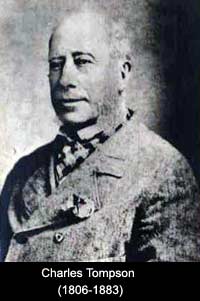
Each well known spot to me is sacred ground…”
In the poem he documented the “sudden Desolation” of the new township when “its tenants fled”. The idea of living on “the tall summit” so as to avoid the flooding of the plains ironically turned out to be impractical, because of a lack of water there.
“Near where the chapel rears its modest top,
And graceful crowns the gently-falling slope,
There is a site where once a hamlet stood.
But now o’ergrown with weeds and underwood…”
Tompson lamented the changes to the landscape that he knew intimately as a youth, especially through the felling of the trees, resulting from “the rude invasions of the spoiling axe”. The area was no longer “circled by a wood”. The “vista’d glade” that he knew was gone.
Reverend Fulton continued his tireless ministry at Castlereagh and throughout the Penrith district until his death on 17 November 1840 at Castlereagh. He was buried with his wife Ann, who died four years earlier, in the Castlereagh cemetery, near the site of his school and parsonage. Their remains are entombed in the family vault built by his daughter for her husband, John MacHenry.
As I walked around the cemetery and read the headstone inscriptions, I quickly realized that I was at the resting place of many of the pioneers who settled and farmed this historic region two hundred years ago. Like many of these early farming communities, Castlereagh was isolated from the main settlement and the lifestyle there was an unimaginable struggle. These families faced the biting cold of the river flats in winter and the sun’s scorching rays in summer. They required great resilience and stoicism towards the devastation wrought by drought and flood on their farming livelihood. There was also the ever present fear, whether real or imagined, from the Aborigines in the district.
Many of these early, farming families still had vivid memories of losing their freedom, then being wrenched from their country and transported in cramped, miserable conditions across the world. At Castlereagh their freedom was returned to them, they had space to move, they lived in a clean, fresh environment and they had ownership of the land they farmed. The area offered them a new beginning and for most it was worth the hardship and struggle that they often had to endure.
The early settlers were very much dependent on each other and most of them often had to develop their skills from scratch, in order to survive. There was a necessary adjustment and understanding required to cope with the strangeness of the country and its unfamiliar climatic patterns. But despite the wild isolation of the place and the roughness of lifestyle, there was a beautiful, serene quality to the landscape.
The slowly decreasing, acute angled rays from the mid afternoon sun glimmered brilliance through the foliage, highlighting some of the sandstone headstones, as I wandered between the them. These clustered like lost souls in various sections of this sacred and historic piece of land. They marked the resting places of many fascinating and extraordinary lives that no gravestone could ever document adequately.
Take for instance the First Fleet English couple, Elizabeth Pulley and Anthony Rope. Their headstones are some of the first you see, standing proudly in their restored state, due to the recent diligence of loving relatives.
Elizabeth Pulley was only twenty-two years old when she was tried at Thetford, in March 1783. She was found guilty of stealing several items of food from a home in December of the previous year. Fortunately, her initial death sentence was changed to seven years transportation.
She left England forever on the Friendship, one of the First Fleet ships, in May 1787. During the voyage, she was placed in leg irons a number of times for fighting and also for being intimate with one or more of the sailors. As early as June, Lieutenant Ralph Clark who dealt with Pulley on the ship, considered her kind to be “whores”, “a disgrace to ther Whole Sex B …s that they are I wish all the Women Wair out of the Ship”(sic). When Governor Phillip came on board in August, he gave orders that Pulley and some other female trouble makers were to be flogged like the men if they continued their bad behaviour. In October she was found pregnant and later transferred to the Charlotte.
On Monday 19 May 1788 she married Anthony Rope. Rope was a twenty- six year old labourer when he was tried at Chelmsford in 1875. He was found guilty of stealing clothing and sentenced to seven years transportation. He experienced first-hand the prison hulks, before sailing with the First Fleet on the Alexander.
The following Sunday after their marriage, the Ropes celebrated their wedding by holding a “supper party” at their tent. But even this happy occasion did not run smoothly for them. At the celebratory party “they had a sea pie, which contained fresh meat”. Five days later the Ropes were brought before Captain David Collins charged with stealing a goat belonging to Lieutenant Johnston. On 2 June a criminal court found them not guilty. The goat was found to be already dead when they, and apparently a wild animal before them, scavenged the carcass for their wedding pie filling.
Anthony Rope unfortunately did not stay out of trouble for long. During the next few years, he was punished for misdemeanours on three separate occasions with twenty-five lashes each time. Besides farming in the Castlereagh area, the Ropes also farmed near Parramatta, at Windsor and South Creek. They are remembered in the latter area by the naming of Rope’s Creek. Anthony Rope was eighty-nine years old when he died at Castlereagh on 20 April 1843. His wife Elizabeth died on the 9 August 1837. She was eighty years old.
The headstone of Eleanor Russell lies on the ground, broken in three pieces. As Eleanor Davis, she arrived in Australia as a convict on board the Mary Ann, part of the Third Fleet, in July 1791. Almost exactly a year before, she had been convicted of stealing items of clothing and sentenced to seven years transportation. She was pregnant on arrival and in September married Alexander Seaton, a convict who also came in the Third Fleet on the Scarborough. His crime had been cattle stealing and he had been transported for life. After the birth of her second daughter at the start of 1794, she took up residence with Jacob Russell. He had been convicted of burglary in 1787. Like Anthony Rope, he experienced time in the prison hulks, before sailing with the Third Fleet on the Salamander in March 1791. In 1794 Jacob was given his first land grant at South Creek where James Ruse was his neighbour. In 1791 Ruse had become the colony’s first freehold farmer, receiving a forty acre land grant at Rose Hill, near Parramatta, from Governor Phillip.
Jacob Russell and his family moved to the Castlereagh area in the early 1800s. Eleanor and Jacob did not marry until after Seaton’s death in Tasmania in 1817. By then Eleanor had given birth to four children by Russell. She was only forty-five years old when she died suddenly on 12 September 1824, “strangled in liquor”. Her death attests to the harshness of life at Castlereagh and the struggle many endured. Jacob was believed to be ninety-six years old when he died in November 1856. Although he did remarry a year after Eleanor’s death, he had no more children. He was buried near Eleanor’s grave at Castlereagh. Like many other people buried there, his grave was unmarked.
Often in the late afternoon, I take a wander through the bushland behind my place to an area known as “The Bluff”. From there I look down on the Nepean River, then across to the Penrith Lakes and on to the Castlereagh area. I envisage the little cemetery I recently visited, tucked away up on the rise. I remember the lives of the people who were buried there. I often think of how they used the opportunities and how they coped with the hardships at Castlereagh. Sometimes I wonder if they ever truly identified with the place and developed a sense of belonging.
© Jim Low
